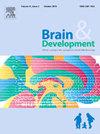A de novo ZMYM2 gene variant associated to a Rett-like phenotype: Case report of a new phenotype and review of the literature
IF 1.4
4区 医学
Q4 CLINICAL NEUROLOGY
引用次数: 0
Abstract
Background
ZMYM2 heterozygous pathogenic variants cause an ultra-rare disease characterized by a broad clinical phenotype. This condition has been named neurodevelopmental-craniofacial syndrome with variable renal and cardiac abnormalities (NECRC, MIM#619522). Associated anomalies include congenital abnormalities of the kidney and urinary tract (CAKUT), non-specific facial, cardiac, and skeletal abnormalities, along with a variety of neurodevelopmental disorders. Other abnormalities reported in some patients include infantile hypotonia, poor growth, microcephaly, hypospadias, and motor stereotypies. Recently, one patient with cerebral palsy embedded in a complex phenotype was reported to carry a pathogenic ZMYM2 variant.
Case presentation
This study presents the case of a 13-year-old girl carrying a de novo ZMYM2 heterozygous pathogenic variant. The patient displayed a Rett-like phenotype, associated with non-specific features such as precocious puberty, short stature, facial dysmorphisms, and spastic diplegia.
Conclusions
This case expands the known clinical phenotype associated with ZMYM2 pathogenic variants, suggesting for the first time a possible link to Rett-like syndromes.
与ret样表型相关的ZMYM2基因新变异:新表型病例报告和文献综述
背景:ZMYM2杂合致病性变异体引起一种以广泛临床表型为特征的超罕见疾病。这种情况被命名为神经发育-颅面综合征伴可变肾和心脏异常(NECRC, MIM#619522)。相关异常包括先天性肾和尿路异常(CAKUT),非特异性面部,心脏和骨骼异常,以及各种神经发育障碍。在一些患者中报道的其他异常包括婴儿张力低下、生长不良、小头畸形、尿道下裂和运动刻板印象。最近,据报道,一名患有复杂表型的脑瘫患者携带致病性ZMYM2变异。病例介绍:本研究报告了一名13岁女孩携带新发ZMYM2杂合致病性变异的病例。患者表现为rett样表型,并伴有非特异性特征,如性早熟、身材矮小、面部畸形和痉挛性双瘫。结论:该病例扩展了已知的与ZMYM2致病变异相关的临床表型,首次提示与ret样综合征的可能联系。
本文章由计算机程序翻译,如有差异,请以英文原文为准。
求助全文
约1分钟内获得全文
求助全文
来源期刊

Brain & Development
医学-临床神经学
CiteScore
3.60
自引率
0.00%
发文量
153
审稿时长
50 days
期刊介绍:
Brain and Development (ISSN 0387-7604) is the Official Journal of the Japanese Society of Child Neurology, and is aimed to promote clinical child neurology and developmental neuroscience.
The journal is devoted to publishing Review Articles, Full Length Original Papers, Case Reports and Letters to the Editor in the field of Child Neurology and related sciences. Proceedings of meetings, and professional announcements will be published at the Editor''s discretion. Letters concerning articles published in Brain and Development and other relevant issues are also welcome.
 求助内容:
求助内容: 应助结果提醒方式:
应助结果提醒方式:


